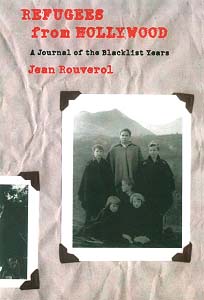REFUGEES FROM HOLLYWOOD--A JOURNAL OF THE BLACKLIST YEARS by Jean Rouverol (University of New Mexico Press, 800-249-7737) is a book that works on various levels. Not only is it a work of movie history (as the subtitle indicates), but a travel book and a family memoir too. In 1951, Jean Rouverol and her husband Hugo Butler were successful Hollywood writers, under contract to Columbia Pictures where they were writing a piece of fluff, a comedy for Bob Cummings and Barbara Hale. Rouverol was also a veteran radio actress, soap opera and fiction writer. Both were leftists who were close to the Communist Party, along with such other even more important screenwriters as

All that changed, suddenly and dramatically. As Rouverol writes, "It was a curious time in American history. Politicians of both parties had quickly learned that they could build whole careers on the single issue of anti-Communism. By the end of the decade a hard-drinking freshman senator named Joseph McCarthy was accusing the State Department of harboring Communists, and--of immediate concern to us--the House of Representatives' Un-American Activities Committee (HUAC) had been garnering banner headlines with their investigations of left-wingers in Hollywood. They were also interested, of course, in discrediting the infant labor movement in the film industry and grilled each witness on his union affiliation as though this too were an ominous symptom of disloyalty. But their primary question was the now famous, 'Are you now or have you ever been a member of the Communist Party? '"
Refusal to answer could lead to a contempt citation and prison. Answering in the affirmative could also have the same result, unless the witness became "friendly"--that is, gave the names of all his leftist friends and acquaintances. Rather than go to prison or become a stool pigeon, some Hollywood lefties fled to Mexico or Europe to avoid being subpoenaed by the committee. Rouverol and Butler chose Mexico City, driving over the border with their four small children.
Most of Refugees From Hollywood deals with Hugo and Jean's struggle to survive as expatriates in a strange land. Without much Spanish or money to their name, they rented a house, found a school for their children, hired a cook (Jean being devoid of domestic skills) and set about learning how to keep their heads above water. Because of the blacklist, Hugo could not find Hollywood work under his own name. But such were his screenwriting skills that black market work did come his way, especially from the famous director, Luis Bunuel, who asked for his help in putting together a Robinson Crusoe script. Bunuel, an anti-Franco Spaniard, was also living as a political exile in Mexico.
Jean Rouverol's portrait of Bunuel is precise and pungent, as is her description of the expat community that swelled in ranks during the McCarthyite 50s. Sharing food, drink and books, helping each other to raise and educate children, find work, learn the language, cope with the vagaries of the Mexican system, stand up to the witch-hunters (who accused this isolated bunch of refugees of running an underground railroad that sent spies to Moscow!), the community was a study in warmth and solidarity.
Jean Rouverol, does not, however, shy away from dealing with the grim side of the blacklist years. Hugo, for example, turned to amphetamines in order to cope with the ferocious pressures on him, and died of arteriosclerotic brain disease at 52. Jean survived, though, and with the end of the blacklist was able to return to Los Angeles, where she continues to write and rule over a brood of six children, seven grand-children, two stepgrandchildren and one great-grandchild.